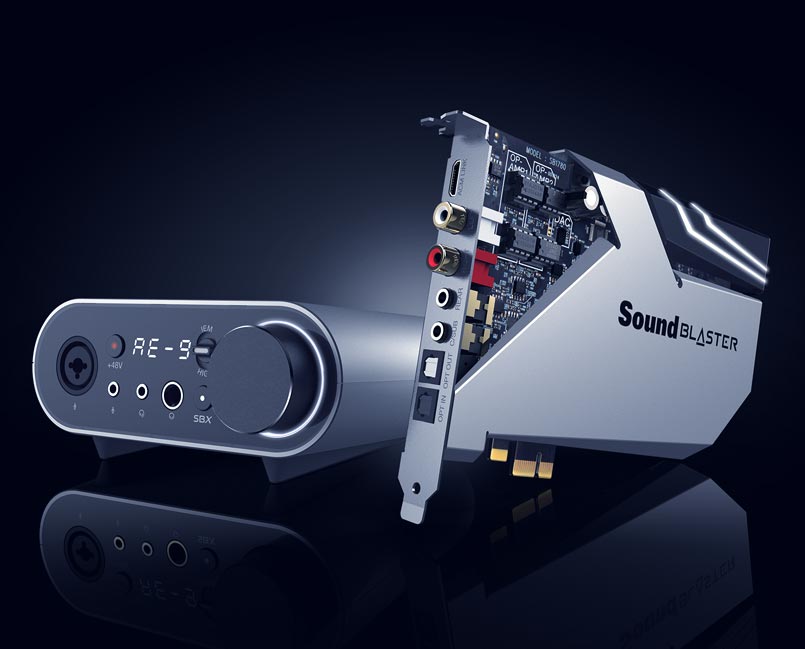

- #SOUND BLASTER SOFTWARE WITH USB MIC DRIVERS#
- #SOUND BLASTER SOFTWARE WITH USB MIC DRIVER#
- #SOUND BLASTER SOFTWARE WITH USB MIC PC#
- #SOUND BLASTER SOFTWARE WITH USB MIC SERIES#
The final item is the mixing effects and SoundBoard. The onboard phantom power and 24-bit audio processor do a great job at delivering high quality recordings and has the added benefit of being cheaper too. On a positive anyone recording with an XLR condenser microphone will not have any of these issues when recording on the Sound Blaster K3+. To be totally honest this is 100% what I had expected and also not required when recording on my Focusrite device. The Fethead requires phantom power and after a quick gain adjustment I was back to recording. The intent is that you to use less microphone gain and get cleaner sound. Lucky for me I have a couple Fethead pre-amplifiers that work to boost the dynamic microphone signal before it gets to the auto processor. When I tried to run the Sound Blaster K3+ with my Procaster dynamic microphones I had to turn the microphone gain up all the way which not only introduced noise in my recording and still wasn’t loud enough. The extra power comes in handy when running Dynamic microphones and for high ohm headphones which is something most USB devices cannot deliver. This is a USB audio interface similar to the Sound Blaster K3+ however it is also externally powered. Sadly every button click gets recorded as a loud snap so that will need to be moinitored and if you leave the FX monitoring enabled and don’t have any effects activated you get some weird feedback from the audio post processor.Įarly in this review I talked about how I use the Focusrite Scarlett 6i6. They are helpful so that you can hear what is being recorded and what effects are applied. I noticed Zero lag on the monitor mix and the audio quality was really good.Īt the top of the unit there are four buttons related to mixing and monitoring. After about 3 minutes of fiddling I was ready to record and was really impressed in the monitoring quality.
#SOUND BLASTER SOFTWARE WITH USB MIC PC#
Moving on I checked my PC audio settings and noticed that the K3+ was indeed active so I started plugging in one of my R0de Procasters and a pair of headphones. (Imagine that hardware just working when you plug it in!) Nothing had installed and honestly, I didn’t think it would work. The system detected the device and never prompted me for anything this making me assume it was needing something.
#SOUND BLASTER SOFTWARE WITH USB MIC DRIVER#
When I first fired up the Sound Blaster K3+ I was honestly looking for a driver disk.
#SOUND BLASTER SOFTWARE WITH USB MIC SERIES#
This is different from a hardware mixer where you may get a series of dials to control mix levels and tune your audio. It is a hardware based interface but configured by software to be flexible and compact. For instance the microphones are studio quality and the audio interface has external power. In my Podcasting setup I have many purposely selected components. This is a USB powered recording and streaming mixer with sound effects processing and a built in sound board. In this review I’ll be going over the Sound Blaster K3+. The one thing we never added was a hardware based mixing system and sound effects. We could use different microphones or a different audio interface with the end result being either a faster setup, more control over the recording process and/or higher quality recordings. Of course there is always room to grow with any recording setup. That process took the better part of 4 hours and is still something we tune every time we sit down to record. As with any dynamic microphone the preamp needs to be set correctly to ensure that excess noise is removed and that you still have ample amplification in your recording.
#SOUND BLASTER SOFTWARE WITH USB MIC DRIVERS#
For instance drivers had to be installed to run the Focusrite Scarlett 6i6 and then it had to be tuned for handle the two R0de Procaster microphones we use. While connecting everything goes pretty quick that wasn’t the case the first time the hardware was setup. Currently this is an audio only show and setting it up is a rather involved task including setting up a PC, hooking up the USB audio interface, headphones and microphones. The show focuses on the PC Hardware community with a touch of overclocking, casemodding and PC gaming.

Readers of Hardware Asylum, and NInjalane before that, will know that we have a monthly computer hardware Podcast.


 0 kommentar(er)
0 kommentar(er)
